Cyclades Log: T-OINOS
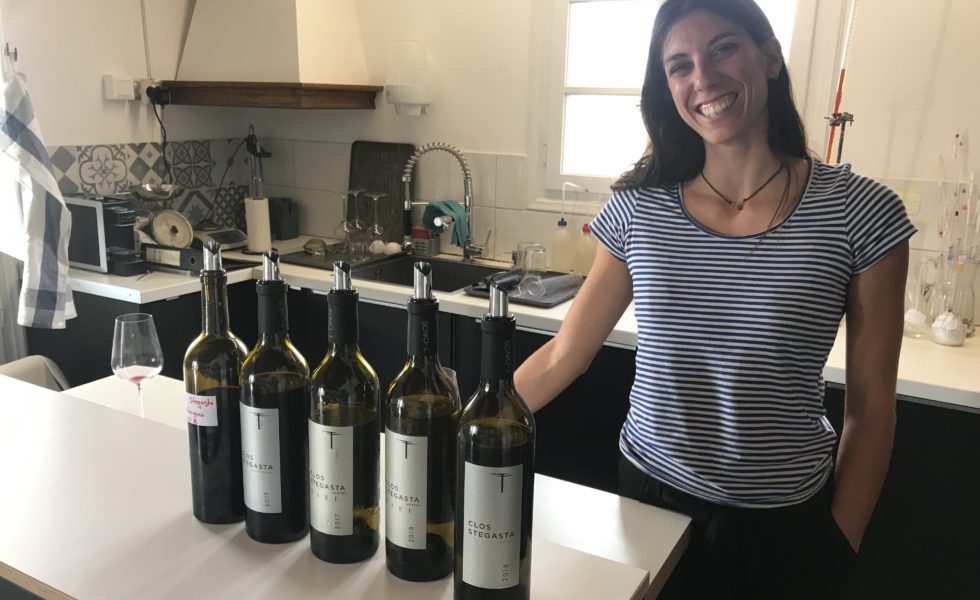
By Panos Kakaviatos for wine-chronicles.com
23 September 2019
French-Greek cooperation had been part of T-OINOS Winery since initial vine plantings in 2002 made T-OINOS a pioneer for Assyrtiko production outside of Santorini in Greece’s Cycladic Islands. Located some 460 meters above sea level on the windy island of Tinos, the winery thrust Tinos into the modern wine-producing era, even if people have made wine there since ancient times.
Extending nearly 200 square kilometers, this northern Cyclades island, with over 50 villages, is far more relaxed and discrete when compared to the chic and expensive Mykonos Island nearby. Its intense northern winds, dubbed “Meltemi”, explain why Tinos is home to the god Aeolus, as I outlined in my more general post about the island earlier this month. As you will discover in this text, the wind matters also for viticulture.
The Stegasta name
The island’s dramatically terraced landscape illustrates historical agricultural activity, with wine production dating back to Prehistory through to the Middle Ages and today.
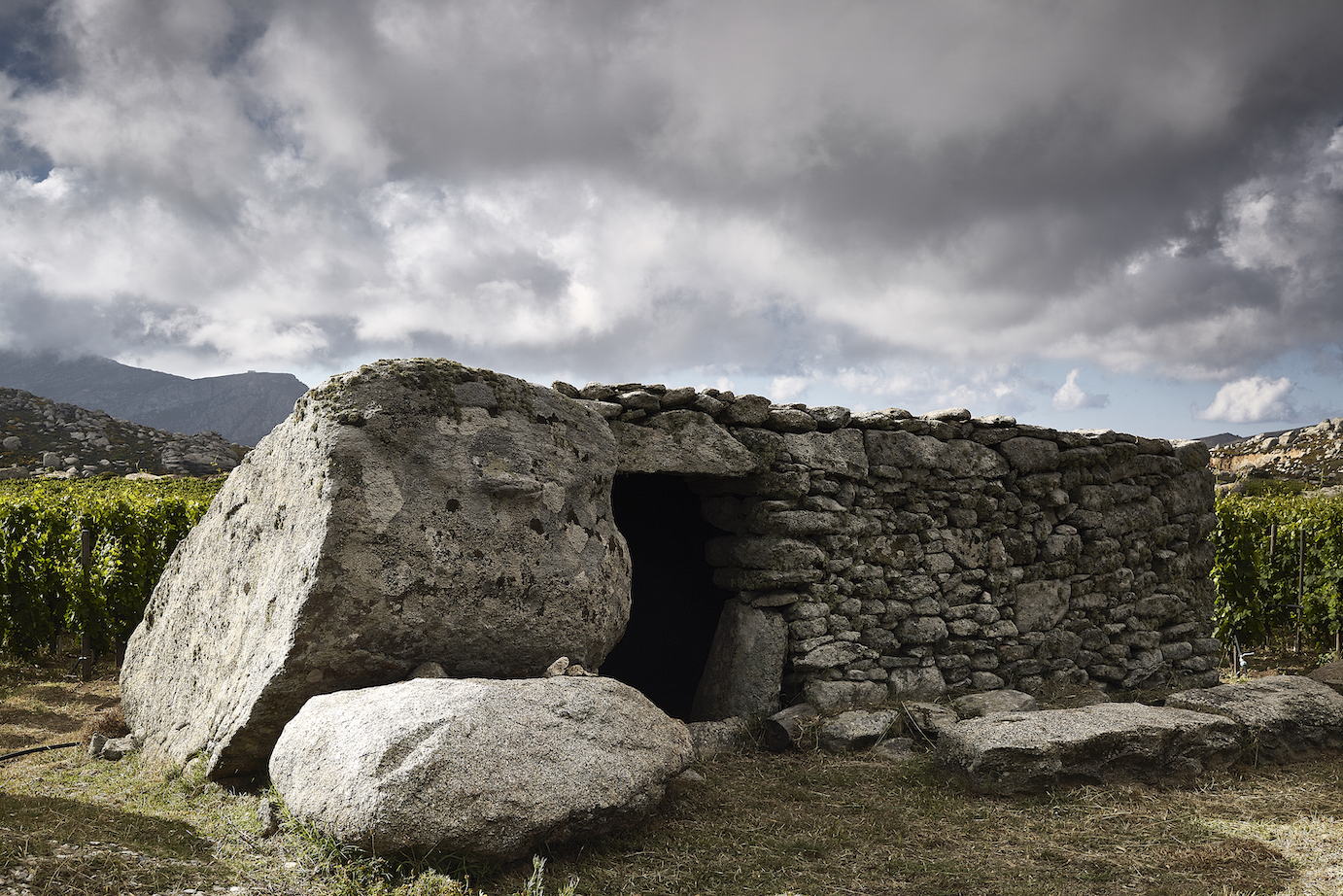
Brought back to life in a different way: Stegasta (photo courtesy of T-OINOS Winery)
By the 18th century, Venetian inhabitants were making 20 different wines on the island, as evidenced by remnants of stone huts, where workers had pressed grapes and fermented wine on the spot, to protect themselves from the strong winds and because it was impractical to haul grapes down the island’s villages. These stony habitats are called “Stegasta”, which means “covered” in Greek, and they explain the name of T-OINOS Winery’s top terroir: “Clos Stegasta”.
I first tried the wines of T-OINOS in 2017 thanks to a master class in Thessaloniki organized by Yiannis Karakasis MW. After trying the wine, I was determined to visit the estate, which was founded by Greek businessman Alexandros Avatangelos and Gerard Margeon, executive head sommelier for Alain Ducasse restaurants worldwide. Both men appreciated the high elevation granite bedrock terroir enough to invest some €8m euros to get 13 hectares of vines producing particularly fresh and elegant reds and whites.
Temperatures are low enough at the high elevation vineyard that workers sometimes wear sweaters in August. The dry, windswept terroir enjoys excellent aeration that prevents development of many potential vineyard maladies. The poor soil forces roots to dig past surface sand into granite bedrock.
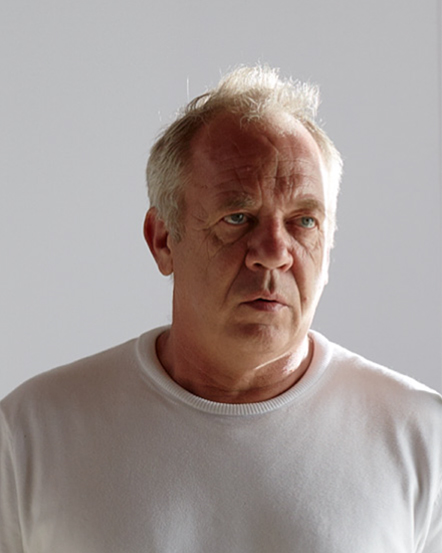
Since 2016 at T-OINOS, celebrated Bordeaux-based winegrower-consultant Stéphan Derenoncourt, who works with over 100 estates all around the world (Photo courtesy of T-OINOS).
Expertise since 2016 with Stéphan Derenoncourt
Bordeaux based consultant Stéphan Derenoncourt further accentuated the Greek-French profile of the winery when he joined T-OINOS in 2016 to oversee viticulture and winemaking. As you can read in my tasting notes from the winery, further down, the result is excellent wine in red and white.
“Derenoncourt comes about once a month to keep en eye on the vineyard as well as to manage winemaking”, said promotion agent Eleni Blouchou, who organized my trip to Tinos, which included two nights of superb lodging at Aeolis Tinos Suites, which I expounded upon in my previous post on Tinos.
Derenoncourt and his team spend much time with new plantings and working the soils. The estate works with botanists to pursue a massale selection of vines. The lunar like surface reflects the arid microclimate, as winds batter the surface at 40 kilometers an hour or sometimes even more.
First row vines bend towards the ground, but most readers here know that vines are tough plants! In any case, the vines of T-OINOS yield quality grapes from which Derenoncourt’s talented team crafts excellent wine.
The Assyrtiko, organically cultivated and planted to an impressive density of 11,500 plants per hectare on eight hectares of granitic sand, offers complex, fresh and clean wines that in optimal vintages like 2018 indeed resemble a crispy yet full bodied grand cru Chablis or top notch Riesling from Alsace.
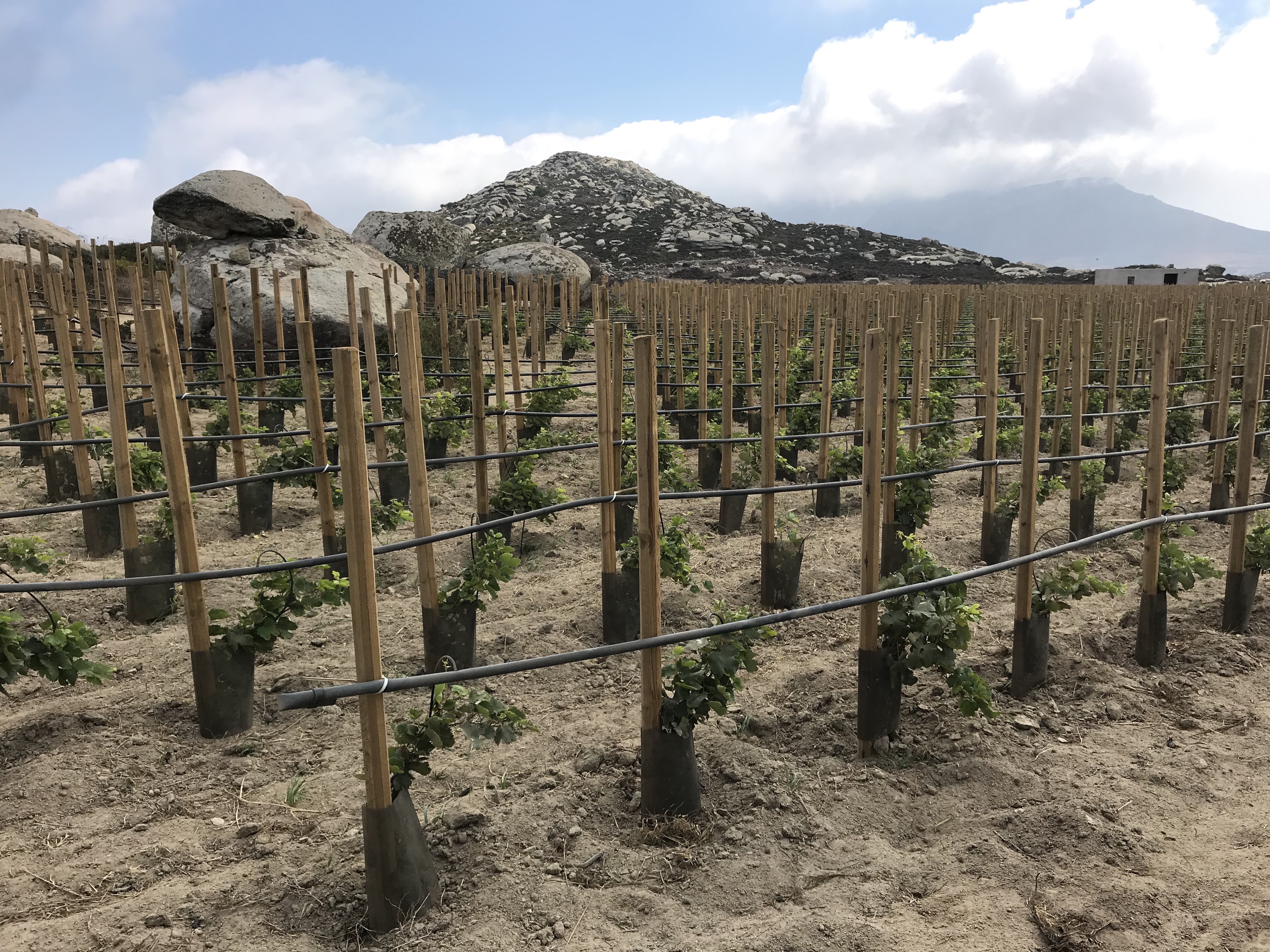
Vines just planted in 2019
The 460-470 meter high Stegasta plateau is the winery’s cream of the crop. It currently includes Mavrotragano black grapes that make lovely reds, with cool blue fruit and wet stone aspects. These Mavrotragano grapes will be uprooted to make room for more Assyrtiko. To some extent I wonder why the team plans to replace all the black grapes from this plateau with Assyrtiko. Then again, the white grape works so very well on this surface – including softer and less precise Malagousia – so I guess it makes sense.
Most of the Mavrotragano for the reds is however planted on clay schist terraces of the Rassonas vineyard: some three hectares 370 meters above sea level, with excellent solar exposure, facing east, so one achieves excellent quality here, as well. For etymologically-minded readers, “Mavro” means black in Greek and “Tragano” crispy. Indeed, another famous black grape in Greece, Xinomavro, literally means “sour” (Xino) and “black”, so what you get from Mavrotragano is a less immediately tannic expression as opposed to the Xinomavro. It comes across more velvety, at least based on my experience comparing the two.
At T-OINOS, you indeed can “experience wines from a site with distinctive rarity”… all you have to do is “to walk on this land and breath the air of Tinos to understand the dimension of the place,” Derenoncourt is quoted as saying on the winery website.
Expansion in the works
Makes sense to me, after having visited the location, an impressive site. Over dinner, I spoke with Julian Lavenu, who works for Derenoncourt. He explains how Assyrtiko can be seen as the “Riesling of the Med”, as the wine communicates both citrus and the soil, like Riesling. “We may be have less acid than Riesling, but you get the wet stone/petrol notes.”
Vintages vary, at such high elevations in particular. For example, the 2017 Assyrtiko, which I enjoyed with Lavenu over dinner, came across riper and just a bit less precise than the 2018, a cooler vintage. Given the high elevation, harvests are later at T-OINOS than on Santorini.
“We seek vintage variation, as in Burgundy”, Lavenu says.
New plantings are planned. Currently, the 13 hectares yield about 25,000 bottles – of all grapes cultivated, not just Assyrtiko. This should jump to 17 hectares by 2025, for 45,000 bottles, along with a new winery that will be built in 2021, says Blouchou.
Challenging harvests
As I wrote recently for decanter.com, Mother Nature has posed challenges: vine stress and blockages due to excessively dry, hot weather have reduced yields. And this year on Tinos, a strong hail storm knocked out up to 40% of the crop at T-OINOS.
As it is the third hail storm to strike since 2002, Lavenu said that the winery may acquire a €50k anti-hail cannon, such as those used in Saint Emilion. “We consider hail enough of a threat to do so,” he said.
In any case, as these tasting notes show, the wines are great. Bravo to T-OINOS for investments they have made – and continue to make – for wine lovers to appreciate.
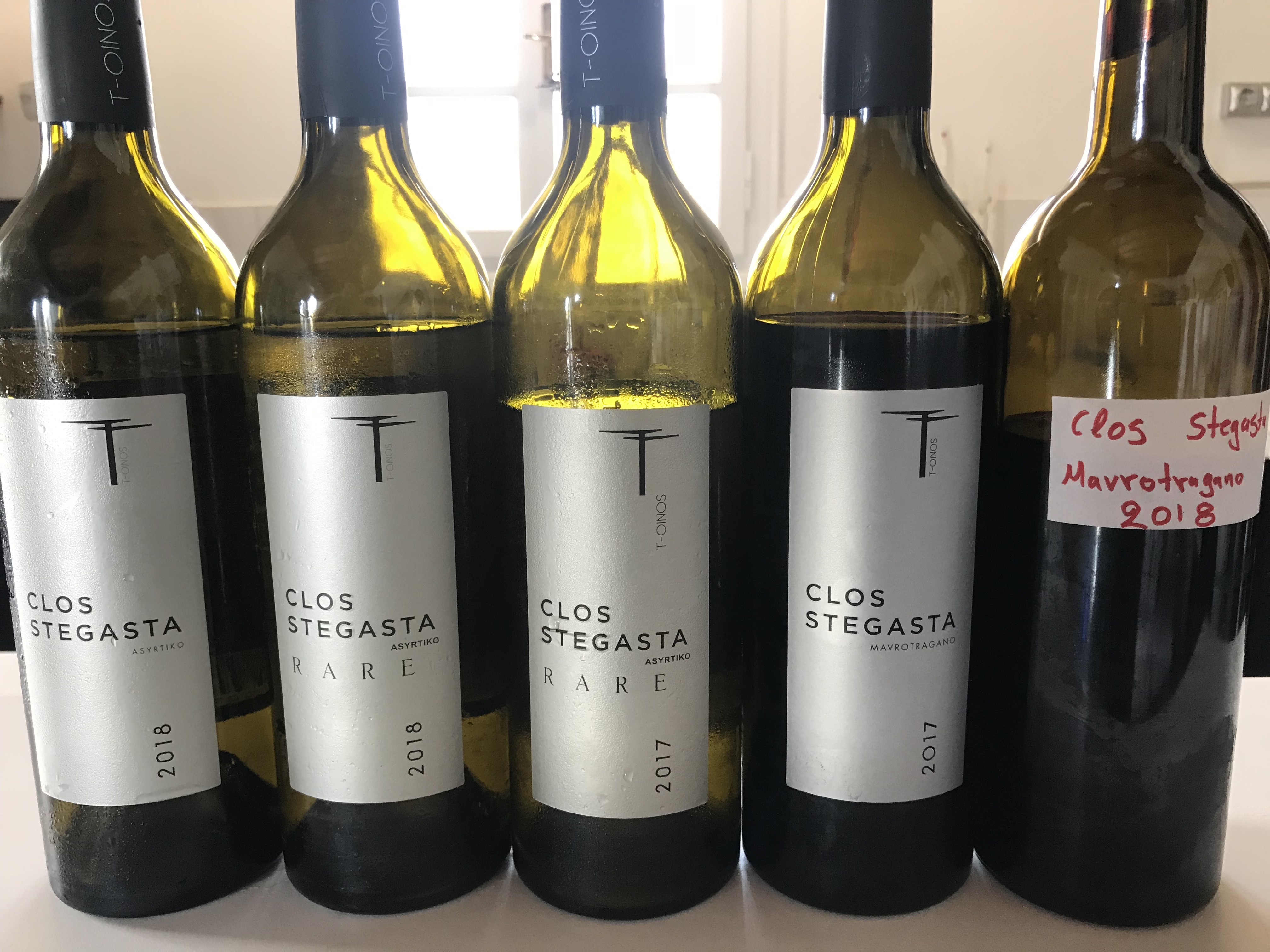
As usual, wines in bold, I liked in particular. When red and bold, even more. And if underlined, too, a kind of wine nirvana.
Clos Stegasta Assyrtiko 2018 – The wine comes from the 8-hectare plot of the same name, whose landscape is like a moonscape. I had enjoyed this same wine over a splendid seafood and fish lunch, as you can read in my previous posting. The wine is nuanced in its Key Lime Pie aspect, at once sumptuous, crisp and bright. Deceptive in its bright expression, because it conveys a very deep and full bodied palate that resembles what one says for grand reds: the fist in the velvet glove 😉. Aged in stainless steel for four months, only 6,000 bottles produced. Retails on average for about €45, according to wine-searcher.com.
Clos Stegasta Assyrtiko Rare 2018 – This bottling is made from the very best grapes harvested. Aged for more time on the lees than the regular version (six months opposed to four), it is slightly thicker in aspect, and slightly darker. The vines are grown on cooler clay soils. It has a slightly more candied citrus nose, a hint of vanilla and shaved almond on the finish. The palate yields greater density than the regular bottling, with a layered texture fit for grand gourmet meals. Only about 2,000 bottles, but in terms of price/quality ratios, I prefer the regular bottle. Needs another year or so to really be ready, too.
Clos Stegasta Rare Assyrtiko 2017 – A warmer vintage and feels that way, along with more evolution, displaying ripe white stone fruit, still strong citrus elements and nut like touches. The palate opulent and nuanced leads to a finish with crushed herb and wet stone. This would be great with turkey roast, pork chops in mango sauce or fettuccini in a cream sauce with grilled shrimp or seared scallops.
Clos Stegasta Mavrotragano 2017 – I love the Syrah-like pepper aspects, with a certain headiness that Lavenu says he would prefer to do without. But it works overall. There is backbone to this wine, which resembles a rich Cote Rôtie. “We will harvest earlier this year, to get more freshness,” Lavenu says. But it really is quite gorgeous already. Bravo! Just about 5,000 bottles. Clocks in at 14.5% alcohol, but you do not feel it. For each vintage thus far, this bottling fetches at least €60 retail.
Clos Stegasta Mavrotragano 2018 (barrel sample) – The bright black berry aspect with damson, and stone like minerality displays a cooler, blueberry fruit nose: brighter than the 2017. I like how the cooler vintage works with these grapes and soils, as the 2018 shows a bit more “breed” than the 2017. Clocks in at about 14% alcohol. Similar price as above.
While the bottles are pricey, by “Greek wine standards”, readers should note not just how well made these are, but also the impressive, high elevation terroir and caring expertise of Stéphane Derenoncourt and his team, which includes the talented enologist Thanos Georgilas, who had worked before at Opus One and Château Latour and assistant enologist Marianna Rapti, who is in the featured image for this post above.
Given the French connection, one would expect several articles in French media, which of course exist. But the winery has seen recent coverage in prominent outlets worldwide, from Germany’s daily Frankfurter Allgemeine Zeitung, by way of Jancis Robinson and Julia Harding in the UK. The wines are served in top French restaurants, with reason. People who think Greek wines should not be “too expensive” should understand that Greece is capable of making wines that can compare to top French labels and in that sense, prices are fair enough.
 Wine Chronicles
Wine Chronicles
Share This